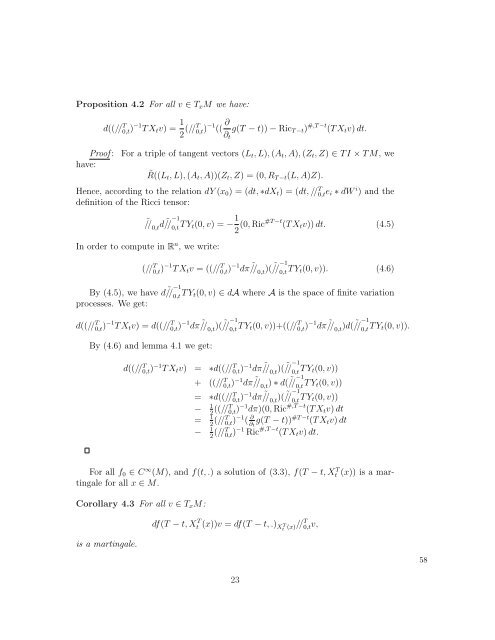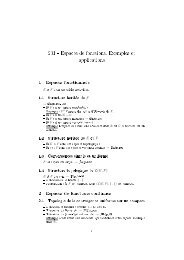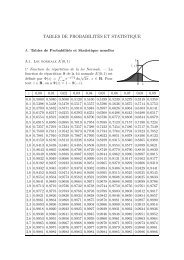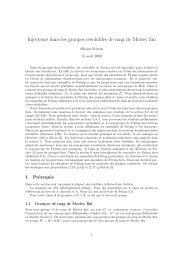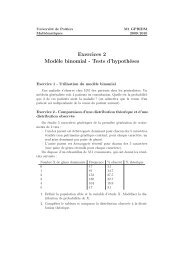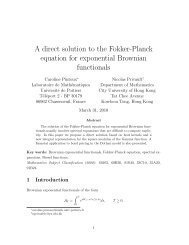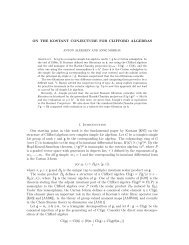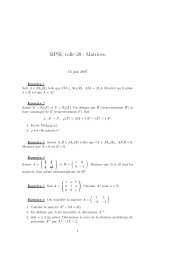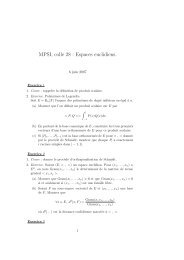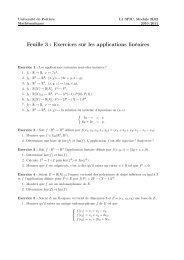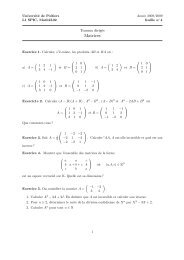Proposition 4.2 For all v ∈ T x M we have:d((// T 0,t) −1 T X t v) = 1 2 (//T 0,t) −1 (( ∂ ∂ tg(T − t)) − Ric T −t ) #,T −t (T X t v) dt.Proof :have:For a triple of tangent vectors (L t , L), (A t , A), (Z t , Z) ∈ T I × T M, we˜R((L t , L), (A t , A))(Z t , Z) = (0, R T −t (L, A)Z).Hence, according to the relation dY (x 0 ) = (dt, ∗dX t ) = (dt, // T 0,te i ∗ dW i ) and thedefinition of the Ricci tensor:−1˜// 0,td ˜//0,t T Y t(0, v) = − 1 2 (0, Ric#T −t (T X t v)) dt. (4.5)In order to compute in R n , we write:(// T 0,t) −1 T X t v = ((// T 0,t) −1 dπ ˜//−10,t)( ˜//0,t T Y t(0, v)). (4.6)−1By (4.5), we have d ˜//0,t T Y t(0, v) ∈ dA where A is the space of finite variationprocesses. We get:d((// T 0,t) −1 T X t v) = d((// T 0,t) −1 dπ ˜//−10,t)( ˜//0,t T Y t(0, v))+((// T 0,t) −1 dπ ˜//−10,t)d( ˜//0,t T Y t(0, v)).By (4.6) and lemma 4.1 we get:d((// T 0,t) −1 T X t v) = ∗d((// T 0,t) −1 dπ ˜//−10,t)( ˜//0,t T Y t(0, v))+ ((// T 0,t) −1 dπ ˜//−10,t) ∗ d( ˜//0,t T Y t(0, v))= ∗d((// T 0,t) −1 dπ ˜//−10,t)( ˜//0,t T Y t(0, v))−1 2 ((//T 0,t) −1 dπ)(0, Ric #,T −t (T X t v) dt= 1 2 (//T 0,t) −1 ( ∂ ∂ tg(T − t)) #T −t (T X t v) dt−1 2 (//T 0,t) −1 Ric #,T −t (T X t v) dt.For all f 0 ∈ C ∞ (M), and f(t, .) a solution of (3.3), f(T − t, X T t (x)) is a martingalefor all x ∈ M.Corollary 4.3 For all v ∈ T x M:is a martingale.df(T − t, X T t (x))v = df(T − t, .) X Tt (x)// T 0,tv,5823
Proof : By differentiation under x of f(T −t, X T t (x)), we get a local martingale.According to [3] and by chain rule for differential we get the corollary. This resultmatches 3.2 after using the above proposition.In an canonical way, we have the following result.Theorem 4.4 The following conditions are equivalent for a family g(t) of metrics:i) g(t) evolves under the forward Ricci flow.ii) For all T < T c we have // T 0,t = W T 0,t = T X t .iii) For all T < T c , the damped parallel transport W T 0,t is an isometry.Proof : By 4.2 and 3.2, for the forward Ricci flow, the result follows by theequation of g(t).5 Second derivative of the stochastic flowWe take the differential of the stochastic flow in order to obtain a intrinsic martingale.We take the same notation as the previous section, and g(t) is a family ofmetrics coming from a forward Ricci flow. Let Xt T (x) be the g(T −t)-BM started atx, constructed as in the previous section by the parallel coupling of a g(T − t)-BMstarted at x 0 , ˜∇ and Y t (x) = (t, Xt T (x)) as before, define the intrinsic trace (thatdo not depend on the choice of E i as below):( ∑)Tr ∇ . T X t (x 0 )(.) := dπ ˜∇ (0,ei )T Y t (x)(0, E i (x)) − T Y t (x) ˜∇ (0,ei )(0, E i (x))iwhere (e i ) is a (T x0 M, g(T )) orthonormal basis, E i are vectors fields in ΓT M suchthat E i (x 0 ) = e i and ˜∇ (0,ei )T Y t (x)(0, E i (x)) is a derivative of a bundle-valuedsemi-martingale in the sense of ([4], [3], [1]). By 4.4:Tr ∇ . T X t (x 0 )(.) := dπ ∑ i˜∇ (0,ei )T Y t (x)(0, E i (x)) − // T 0,tdπ( ∑ i˜∇ (0,ei )(0, E i (x)))Theorem 5.1 Let L t := (// T 0,t) −1 Tr ∇ . T X t (x 0 )(.) be a (T x0 M, g(T ))-valued process,started at 0. Then:i) L t is a (T x0 M, g(T ))-valued martingale, independent of the choice of E i .ii) The g(T )-quadratic variation of L is given by d[L, L] t =‖ Ric T −t (X t (x 0 )) ‖ 2 T −tdt.5924
- Page 1:
Université de PoitiersTHÈSEpour o
- Page 4 and 5:
AbstractIn the first part of this t
- Page 6 and 7:
ivTABLE DES MATIÈRES3 Kendall-Cran
- Page 8 and 9: 8 CHAPITRE 1. INTRODUCTIONdifféren
- Page 10 and 11: 10 CHAPITRE 1. INTRODUCTIONdonne se
- Page 12 and 13: 12 CHAPITRE 1. INTRODUCTIONHamilton
- Page 14 and 15: 14 CHAPITRE 1. INTRODUCTIONx et ell
- Page 16 and 17: 16 CHAPITRE 1. INTRODUCTIONCette é
- Page 18 and 19: 18 CHAPITRE 1. INTRODUCTION- Exempl
- Page 20 and 21: 20 CHAPITRE 1. INTRODUCTION20
- Page 22 and 23: 22CHAPITRE 2. INTRODUCTION À L’A
- Page 24 and 25: 24CHAPITRE 2. INTRODUCTION À L’A
- Page 26: 26CHAPITRE 2. INTRODUCTION À L’A
- Page 29 and 30: 2. ÉQUATIONS DIFFÉRENTIELLES STOC
- Page 31 and 32: 2. ÉQUATIONS DIFFÉRENTIELLES STOC
- Page 33 and 34: 3. QUELQUES APPLICATIONS DU CALCUL
- Page 35 and 36: Chapitre 3Brownian motion with resp
- Page 37 and 38: for every smooth function f,is a lo
- Page 39 and 40: For the solution U t of (1.1) we ge
- Page 41 and 42: Remark : Recall that in the compact
- Page 43 and 44: 2 Local expression, evolution equat
- Page 45 and 46: The last equality comes from Green
- Page 47 and 48: Theorem 3.2 For every solution f(t,
- Page 49 and 50: Consequently:d(df(T − t, .) X Tt
- Page 51 and 52: Proof : The first remark after theo
- Page 53 and 54: Remark : Hamilton gives a proof of
- Page 55 and 56: Corollary 3.7 For χ(M) < 0, there
- Page 57: We also have:D S,T −t dπ ˜// 0,
- Page 61 and 62: where we have used in the second eq
- Page 63 and 64: [10] K. D. Elworthy and M. Yor. Con
- Page 65 and 66: Chapter 4Some stochastic process wi
- Page 67 and 68: We will just look at the smooth sol
- Page 69 and 70: that is to say:d(Y T,it ) = − ∂
- Page 71 and 72: 2 Tightness, and first example on t
- Page 73 and 74: proof : It is clear that F is smoot
- Page 75 and 76: Proposition 2.6 Let g(t) be a famil
- Page 77 and 78: v) ˜g(∞) is a metric such that (
- Page 79 and 80: Then:for all ɛ > 0 , there exists
- Page 81 and 82: Finally, we obtain:∂∂t | t=t 0
- Page 83 and 84: where Ut 3 is the horizontal lift o
- Page 85 and 86: √πWe can choose ɛ, ɛ 2 such th
- Page 87 and 88: We will now show that the coupling
- Page 89 and 90: HenceWe get:√√ n∑1 − ɛI t
- Page 91 and 92: By uniqueness in law of such proces
- Page 95 and 96: Chapter 5Horizontal diffusion in pa
- Page 97 and 98: 2 M. ARNAUDON, A. K. COULIBALY, AND
- Page 99 and 100: 4 M. ARNAUDON, A. K. COULIBALY, AND
- Page 101 and 102: 6 M. ARNAUDON, A. K. COULIBALY, AND
- Page 103 and 104: 8 M. ARNAUDON, A. K. COULIBALY, AND
- Page 105 and 106: 10 M. ARNAUDON, A. K. COULIBALY, AN
- Page 107 and 108: 12 M. ARNAUDON, A. K. COULIBALY, AN
- Page 109 and 110:
14 M. ARNAUDON, A. K. COULIBALY, AN
- Page 111 and 112:
16 M. ARNAUDON, A. K. COULIBALY, AN
- Page 113 and 114:
Chapter 6Compléments de calculs113
- Page 115 and 116:
d’avoir une famille de connexion,
- Page 117 and 118:
Dans le calcul de ligne 8 à ligne
- Page 119 and 120:
On utilise le fait que W (.) t est
- Page 121 and 122:
Chapter 7Appendix121121
- Page 123 and 124:
774 M. Arnaudon et al. / C. R. Acad
- Page 125 and 126:
776 M. Arnaudon et al. / C. R. Acad
- Page 127 and 128:
778 M. Arnaudon et al. / C. R. Acad
- Page 129 and 130:
Bibliography[ABT02]Marc Arnaudon, R
- Page 131 and 132:
BIBLIOGRAPHY 131[DeT83][Dri92]Denni
- Page 133 and 134:
BIBLIOGRAPHY 133[Jos84][Jos05][JS03
- Page 135 and 136:
135


